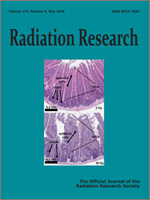Gastrointestinal (GI) injury is a major cause of acute death after total-body exposure to large doses of ionizing radiation, but the cellular and molecular explanations for GI death remain dubious. To address this issue, we developed a murine abdominal irradiation model. Mice were irradiated with a single dose of X rays to the abdomen, treated with daily s.c. injection of N-acetyl-l-cysteine (NAC) or vehicle for 7 days starting either 4 h before or 2 h after irradiation, and monitored for up to 30 days. Separately, mice from each group were assayed 6 days after irradiation for bone marrow reactive oxygen species (ROS), ex vivo colony formation of bone marrow stromal cells, and histological changes in the duodenum. Irradiation of the abdomen caused dose-dependent weight loss and mortality. Radiation-induced acute death was preceded not only by a massive loss of duodenal villi but also, surprisingly, abscopal suppression of stromal cells and elevation of ROS in the nonirradiated bone marrow. NAC diminished these radiation-induced changes and improved 10- and 30-day survival rates to >50% compared with <5% in vehicle-treated controls. Our data establish a central role for abscopal stimulation of bone marrow ROS in acute death in mice after abdominal irradiation.
How to translate text using browser tools
18 February 2010
Prevention and Mitigation of Acute Death of Mice after Abdominal Irradiation by the Antioxidant N-Acetyl-cysteine (NAC)
Dan Jia,
Nathan A. Koonce,
Robert J. Griffin,
Cassie Jackson,
Peter M. Corry
ACCESS THE FULL ARTICLE

Radiation Research
Vol. 173 • No. 5
May 2010
Vol. 173 • No. 5
May 2010




